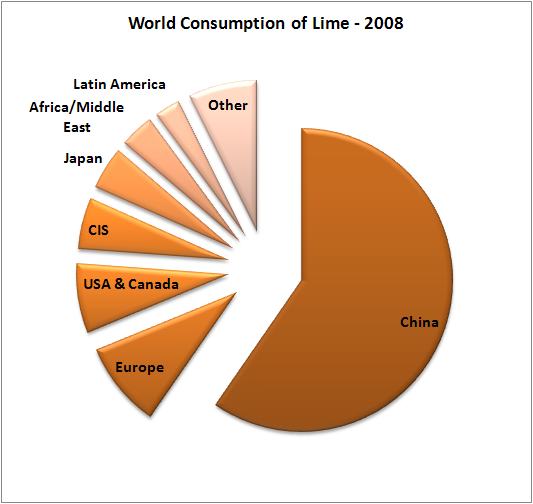Lime Market is to Recover and Grow by 3 – 5% in the Coming Years
08 Jun 2010 • by Natalie Aster

Lime is a widespread and variously used chemical material, produced and consumed all over the world. Taking into account minor producers in developing countries and producers of Lime for internal needs (metallurgic works, pipe-and-paper and sugar mills), global Lime production is estimated at 300 mln tons annually. In 2008 China was the largest producer of Lime. It accounted for 60% of the overall production volume.
Lime production increased significantly in 2005-2007 due to the manufacturing growth in major consumption fields. The growth in construction industry and refractory products production was caused generally by demand increase in developing regions, China, in particular. In the USA and Europe the total consumption continued to grow at a moderate rate.
In 2008 the growth slowed down abruptly, it was caused by demand decrease in Europe and North America due to the output decline. At that period Lime consumption per capita dropped up to 80 kg in industrialized countries.
In 2009 demand for Lime continued to decline. Lime consumption dropped in most regions, excluding China and India, where consumption growth just experienced a slow-down.
The global Lime consumption breakdown is presented in the following chart:
It is forecast that market recovery will take place at a slow rate. An analysis of the consumers sectors allows to project an annual 3-5% growth.
European countries have been the leading global Lime exporters for years: Germany (16% of total export), France (16%), Belgium (15%). Considering export of different types of Lime, the picture seems to be the same. The leading positions in Quick Lime export are taken by Germany (22%), France (20%), Belgium (14%). Major exporters of Slaked Lime are Belgium (20%) and Germany (12%). The Hydraulic Lime market is lead by France (21%) and Germany (18%).
In Europe, North America and Japan the Lime production sector is characterized by regional producers activities, each one operating on a respective regional market. Here, manufacturers are engaged in captive Lime production due to the technological process. Only low-capacity factories or ferroalloy producers, using small volumes of Lime, buy the material outside.
There is a relatively small number of companies (JMS Jura Marble Suppliers GmbH, Rocamat S.A., Carmeuse Group, Carmeuse Lime & Stone, Atlantic Minerals Limited, Thang Kiang Nam Trading Sdn. Bhd., CJSC Lime Factory, etc.), engaged in global trade, firstly because Lime is available in all the parts of the world and shipment costs can influence the Lime price heavily.
The sphere of Lime use is multifaceted. The major consumers of this material are:
- Slaked Lime – in production of dry construction mixture;
- Hydraulic Lime - is a basis for water-resistant construction mixture for constructing parts of buildings in wet conditions: Water Lime is also used in production of low-grade concrete and slag-lime cements;
Related Research:
- Trends and Prospects in International Trade in Quicklime
- Trends and Prospects in International Trade in Slaked Lime
- Trends and Prospects in International Trade in Hydraulic Lime
- China Cement, Lime and Plaster Industry Profile – ISIC2694
- United States Lime and Minerals, Inc.: SWOT Analysis and Company Profile
- Lime Market Research in Russia
- Limestone and Lime Market Research in Russia
- Limestone Market Research in Russia
To order or get a free sample of any report, feel free to contact [email protected]
Source: MarketPublishers, Ltd.
Analytics & News

